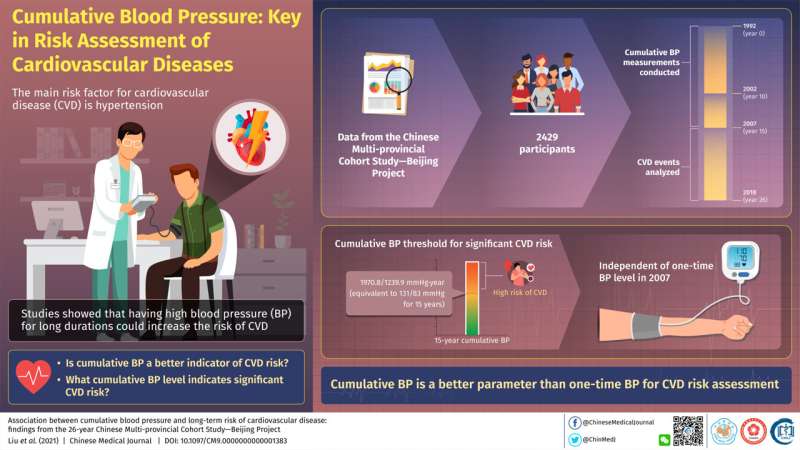Maintaining normal blood pressure over long term is the key to heart health, study finds


A global leading cause of death today is a class of dreaded disorders called cardiovascular diseases (CVD), which are ailments of the heart and blood vessels, such as arrhythmia, stroke, coronary artery diseases, cardiac arrest, and so on. The causes for each CVD are different and can be genetic or lifestyle related, but one key risk factor is hypertension, also known as high blood pressure (BP). For instance, as a recent paper published in Chinese Medical Journal notes, in 2017, hypertension was a factor in over 2.5 million deaths in China alone, 95.7% of which were due to CVD.
In this paper, Dr. Jing Liu, expert in the epidemiology of cardiovascular diseases at the Beijing Institute of Heart, Lung, and Blood Vessel Diseases, along with a team of researchers, explores exactly how much hypertension puts a person at significant risk of CVD. As the 2017 statistic shows, the team’s study comes at a time when there is a pressing need to make informed decisions on managing hypertension appropriately.
The team began their research at the heels of recent findings in other studies, where it was observed that CVD risk can be elevated for a person even if their BP is below the clinical threshold of hypertension, and having hypertension for longer periods of time, such as several years, can amplify the risk of CVD. So perhaps the cumulative BP over a certain period of time, instead of the BP measured at only one point of time, would be a better indicator of the risk of CVD? Studies seemed to indicate as such, but exactly how much cumulative BP meant significant risk of CVD remained a mystery.
To find out, Dr. Liu’s team analyzed data from a 26-year follow-up of the Chinese Multi-provincial Cohort Study-Beijing Project. From the data for the first 15 years, from 1992 to 2007, they calculated the cumulative BP levels of 2429 participants who were free of CVD at 2007. From the data for 2007 to 2018, the number of CVD incidents among these participants were registered.
Between 2007 to 2018, 207 CVD events had occurred. The incidence of these events was greater among participants with higher cumulative BP. This suggested that cumulative BP was indeed a reliable measure of the risk of CVD.
Further, it appeared that having a cumulative BP level higher than 1970.8/1239.9 mmHg·year—equivalent to maintaining a BP level higher than 131/83 mm/Hg for 15 years—was associated with increased CVD risk. The team had arrived at the elusive threshold value they had set out to find. This value remained true even for participants whose BP values were within limits when measured in 2007. Conversely, if a participant’s BP was high in 2007 but their cumulative BP over the 15 years preceding was low, their risk of CVD was low. Thus, cumulative BP was a better indicator of CVD risk than BP measured at one time.
Highlighting a key practical implication of this last finding, Dr. Liu says, “Our findings show that long-term exposure to high blood pressure may increase your risk of cardiovascular disease, although your current blood pressure level is lower than the diagnostic criterion of hypertension. For example, a person with current blood pressure level of 120/70 mmHg, which is within the normal range, could still be at a higher risk of contracting a cardiovascular disease in the future if his/her blood pressure level used to be higher than 130/80 mmHg for a long time, say years, in the past.”
“This study underscores the importance of starting BP management early,” Dr. Liu continues. Lifestyle changes to keep BP in check, coupled with regular monitoring, can go a long way. In addition, waiting to medicate until the BP levels have become chronically high is not wise.
Dr. Liu also suggests a paradigm shift in the way hypertension is monitored by medical professionals. “We wish for our research to guide health care providers to pay attention to a patient’s previous blood pressure levels and duration for which BP has been high, in addition to current levels. This will help to identify individuals at a higher risk of cardiovascular disease in the future.”
Source: Read Full Article